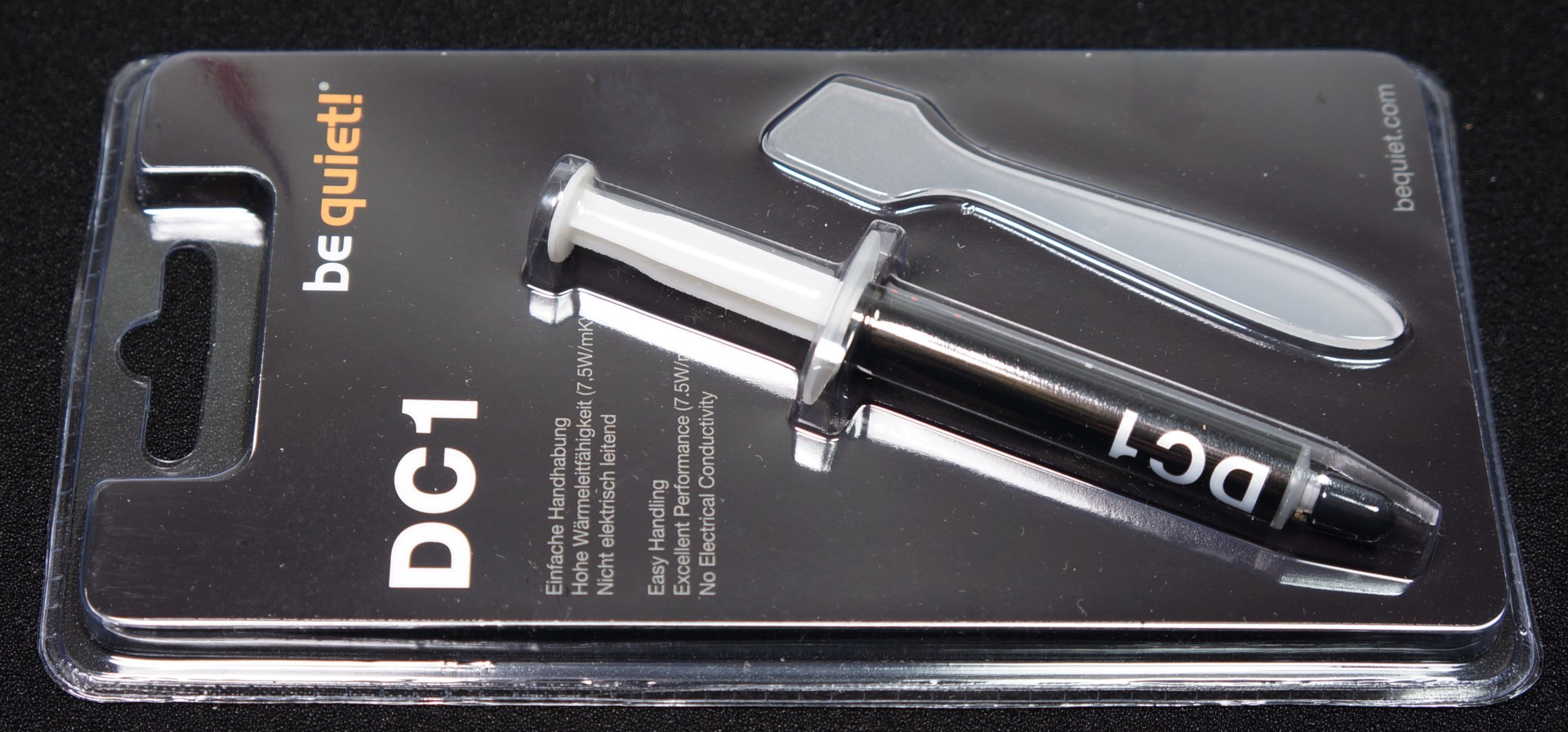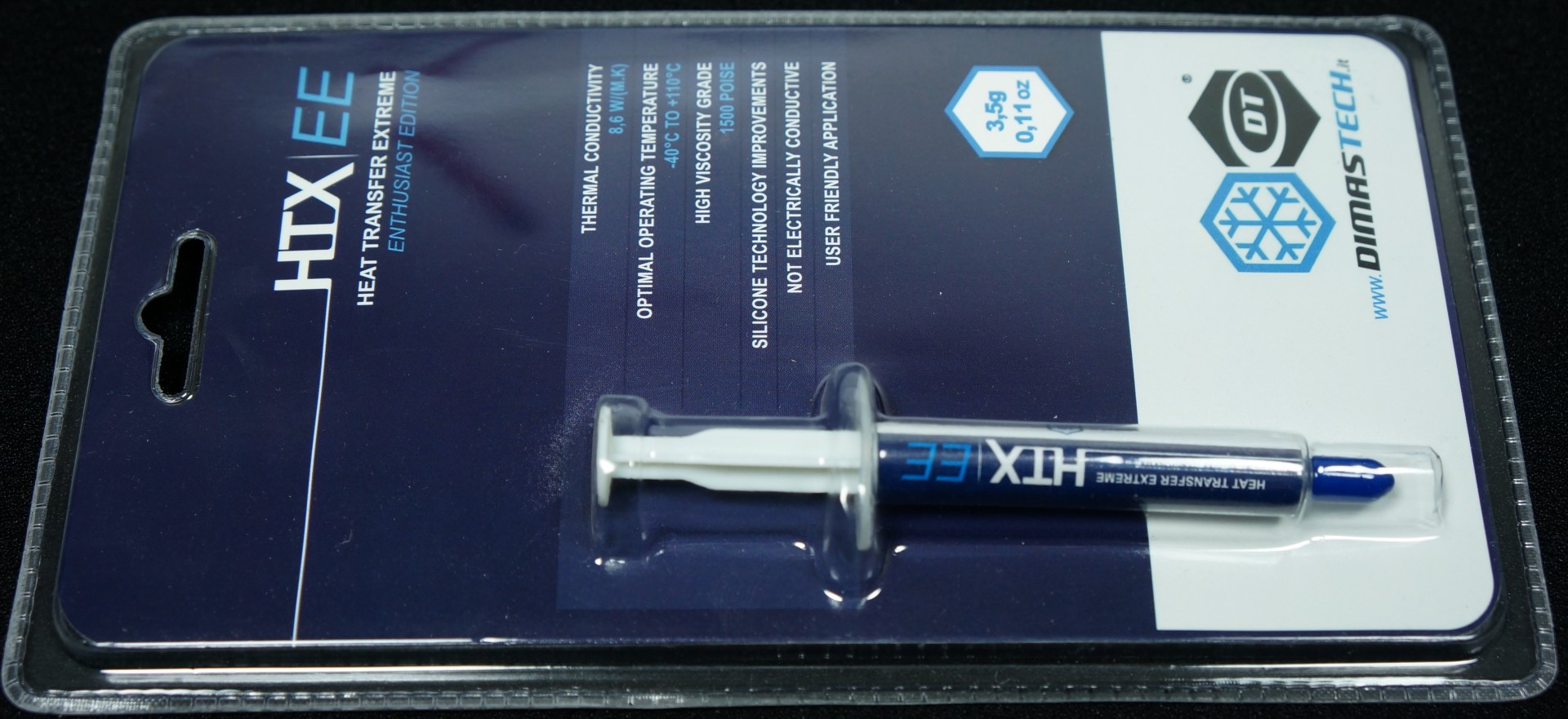Thermal Paste Comparison, Part Two: 39 Products Get Tested
It's time for the numbers. In addition to testing liquid metal compounds and thermally conductive adhesives, each paste is discussed on its own merits before we chart out the results of four usage cases. After all, these products behave differently.
Pastes: be quiet!, Corsair, And Dimastech
be quiet! DC 1
As with a number of other manufacturers, be quiet! merely puts its label on an OEM product. That doesn't necessarily indicate poor quality, so long as the OEM maintains certain standards. And as it turns out, the DC 1 is a solid paste for beginners, ending up in the upper mid-range. Its handling is similar to MX-2, while its performance is a notch better. While we like the product’s quality, we cannot say the same about pricing. Amazon currently offers 3 g for close to $10.
| be quiet DC 1 | |
|---|---|
| Thermal Conductivity | 7.5 W/(m*K) |
| CPU Water Cooling, High Pressure | 32.7 ΔT (22 °C ambient) |
| CPU Air Cooling, High Pressure | 36.6 ΔT (22 °C ambient) |
| CPU Air Cooling, Low Pressure | 37.4 ΔT (22 °C ambient) |
| GPU Cooling | 67.0 ΔT (22 °C ambient) |
| Electrically Conductive | No |
| Viscosity | 2 (1-10, lower numbers mean easier to use) |
| Ease of Use | 8 (1-10, higher numbers mean easier to use) |
| Application Hints | This paste seems best suited for the "lentil ball" method, and can even be used in unheated rooms in winter, as low as 50 °F |
| Price (approximate) | $10 (3 grams) |
be quiet! (Paste Bundled with be quiet! Heat Sinks)
We're curious about the pastes that heat sink vendors bundle with their coolers. Since cost is always a factor when it comes to value-adds, we want to know whether it makes sense to toss the included stuff and buy aftermarket compound instead.
In this case, we are positively surprised by the freebie. It should be good enough to complement be quiet!'s coolers, which employ high mounting pressure. Under those conditions, the paste comes in a mere 0.6 °C higher than the DC 1, mentioned above.
| be quiet! (Paste Bundled with be quiet! Heat Sinks) | |
|---|---|
| Thermal Conductivity | Data not available |
| CPU Water Cooling, High Pressure | 33.6 ΔT (22 °C ambient) |
| CPU Air Cooling, High Pressure | 37.2 ΔT (22 °C ambient) |
| CPU Air Cooling, Low Pressure | 37.4 ΔT (22 °C ambient) |
| GPU Cooling | 68.5 ΔT (22 °C ambient) |
| Electrically Conductive | No |
| Viscosity | 2 (1-10, lower numbers mean easier to use) |
| Ease of Use | 8 (1-10, higher numbers mean easier to use) |
| Application Hints | This paste seems best suited for the "lentil ball" method, and can even be used in unheated rooms in winter, as low as 50 °F |
| Price (approximate) | N/A |
Corsair (Paste Enclosed With Corsair Coolers)
This time we're looking at thermal paste bundled with Corsair's coolers. The be quiet! and Corsair compounds achieve similar results, though Corsair's paste is perhaps slightly thicker. It's still pretty easy to use though, and we like what we see from our thermal performance results. In this case, it probably wouldn't make much sense to toss the tube and spend good money on something else.
| Corsair (Paste Bundled with Corsair Heat Sinks) | |
|---|---|
| Thermal Conductivity | Data not available |
| CPU Water Cooling, High Pressure | 33.4 ΔT (22 °C ambient) |
| CPU Air Cooling, High Pressure | 37.2 ΔT (22 °C ambient) |
| CPU Air Cooling, Low Pressure | 37.6 ΔT (22 °C ambient) |
| GPU Cooling | 68.5 ΔT (22 °C ambient) |
| Electrically Conductive | No |
| Viscosity | 3 (1-10, lower numbers mean easier to use) |
| Ease of Use | 8 (1-10, higher numbers mean easier to use) |
| Application Hints | This paste seems best suited for the "lentil ball" method, and should be used in average-temperature rooms, from 70 °F |
| Price (approximate) | N/A |
Dimastech HTX-EE
This compound is one of the most difficult to use, and you should only apply it after warming to 110 °F or so. Its performance results are barely better than what you get for free with some heat sinks, though, and so we're left a little disappointed. We're not saying that this is a bad paste, but for the money you can find better options. This stuff is so thick that we were afraid our heat sink's screws would strip their threads as we tightened them.
Get Tom's Hardware's best news and in-depth reviews, straight to your inbox.
| Dimastech HTX-EE | |
|---|---|
| Thermal Conductivity | 8.6 W/(m*K) |
| CPU Water Cooling, High Pressure | 33.0 ΔT (22 °C ambient) |
| CPU Air Cooling, High Pressure | 37.1 ΔT (22 °C ambient) |
| CPU Air Cooling, Low Pressure | 37.6 ΔT (22 °C ambient) |
| GPU Cooling | 69.5 ΔT (22 °C ambient) |
| Electrically Conductive | No |
| Viscosity | 7 (1-10, lower numbers mean easier to use) |
| Ease of Use | 2 (1-10, higher numbers mean easier to use) |
| Application Hints | At room temperature, this paste should not be used with the "lentil ball" method. Warm it to 100-120 degrees Fahrenheit in a pot of water, sealed in a water-tight pouch. |
| Price (approximate) | $6 (3.5 grams) |
Current page: Pastes: be quiet!, Corsair, And Dimastech
Prev Page Pastes: Arctic And Arctic Silver Next Page Pastes: Coollaboratory
Igor Wallossek wrote a wide variety of hardware articles for Tom's Hardware, with a strong focus on technical analysis and in-depth reviews. His contributions have spanned a broad spectrum of PC components, including GPUs, CPUs, workstations, and PC builds. His insightful articles provide readers with detailed knowledge to make informed decisions in the ever-evolving tech landscape
-
dragonfang18 I loved the toothpaste part. What about Vicks Vaporub? I wonder how that thing would do.Reply -
TehDudeMan Great article guys! As a reader for over 10 years pretty much daily, this reminds me of the old Tom's Hardware. These type of in depth articles on enthusiast products are what I love.Reply -
Matt Edwards A great article, agree the application of the compound, not the compound itself is most important.Reply
Like ledpellet I too am curious about these diamond compounds. Wonder if it offers similar results to the Coollaboratory products with an easier application, or if the results simply don't justify the price. E.g in Australia, Innovation Cooling IC7 Diamond 7 Carat Thermal Compound Paste - 1.5G can be found for as much as $25. The cheapest I have managed to find it for is $15. For that price it would want to be good considering the leading GELID GC Extreme, can be found for around $8. -
danwat1234 Coollaboratory Liquid Ultra isn't all that good after a year of hard use. In fact, it completely hardens / dries. On my X9100 after 9 months of nearly 24/7 100% load, I started seeing high temps and after 1 year auto shut downs while crunching. Turns out it was shutting off because it hit the 105 C thermal protection.Reply
Opened it up; thermal compound was as hard as a rock. has to pocket knife blade and sand it down.
So for longevity it sucks. That is something to consider, not just initial performance, but performance months and years down the road. Especially for laptops that aren't designed to be opened up frequently for repasting.
After trying Liquid Ultra many times and having it fail on me, I've put on Arctic MX-2 that has a supposed 8 year durability rating. Initial performance is great, we'll see how it lasts (been 3 weeks so far). -
slomo4sho CLU and Arctic MX-4 are both great products. MX-2 and MX-4 can often be found free after rebate so they are an exceptional value.Reply



